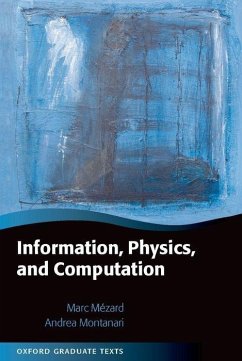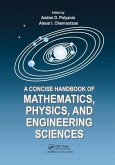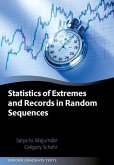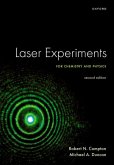Marc Mezard (Laboratoire de Physique Theorique et Modeles Statist, Andrea Montanari (Electrical Engineering and Statistics Departmen
Information, Physics, and Computation
Marc Mezard (Laboratoire de Physique Theorique et Modeles Statist, Andrea Montanari (Electrical Engineering and Statistics Departmen
Information, Physics, and Computation
- Gebundenes Buch
- Merkliste
- Auf die Merkliste
- Bewerten Bewerten
- Teilen
- Produkt teilen
- Produkterinnerung
- Produkterinnerung
A very active field of research is emerging at the frontier of statistical physics, theoretical computer science/discrete mathematics, and coding/information theory. This book sets up a common language and pool of concepts, accessible to students and researchers from each of these fields.
Andere Kunden interessierten sich auch für
![Introduction to Quantum Field Theory with Applications to Quantum Gravity Introduction to Quantum Field Theory with Applications to Quantum Gravity]() Joseph Buchbinder (Tomsk State P Department of Theoretical PhysicsIntroduction to Quantum Field Theory with Applications to Quantum Gravity53,99 €
Joseph Buchbinder (Tomsk State P Department of Theoretical PhysicsIntroduction to Quantum Field Theory with Applications to Quantum Gravity53,99 €![A Concise Handbook of Mathematics, Physics, and Engineering Sciences A Concise Handbook of Mathematics, Physics, and Engineering Sciences]() Andrei D. PolyaninA Concise Handbook of Mathematics, Physics, and Engineering Sciences73,99 €
Andrei D. PolyaninA Concise Handbook of Mathematics, Physics, and Engineering Sciences73,99 €![When Things Grow Many When Things Grow Many]() Lawrence Schulman (Professor of Physics, Professor of Physics, ClarWhen Things Grow Many68,99 €
Lawrence Schulman (Professor of Physics, Professor of Physics, ClarWhen Things Grow Many68,99 €![Path Integrals in Quantum Mechanics, Statistics, Polymer Physics, and Financial Markets (5th Edition) Path Integrals in Quantum Mechanics, Statistics, Polymer Physics, and Financial Markets (5th Edition)]() Hagen Kleinert (Germany Freie Univ Berlin)Path Integrals in Quantum Mechanics, Statistics, Polymer Physics, and Financial Markets (5th Edition)45,99 €
Hagen Kleinert (Germany Freie Univ Berlin)Path Integrals in Quantum Mechanics, Statistics, Polymer Physics, and Financial Markets (5th Edition)45,99 €![Statistics of Extremes and Records in Random Sequences Statistics of Extremes and Records in Random Sequences]() Prof Satya N. Majumdar (Director of Research, Director of Research,Statistics of Extremes and Records in Random Sequences65,99 €
Prof Satya N. Majumdar (Director of Research, Director of Research,Statistics of Extremes and Records in Random Sequences65,99 €![Laser Experiments for Chemistry and Physics, Second Edition Laser Experiments for Chemistry and Physics, Second Edition]() Prof Robert N. Compton (Professor Emeritus of Physics and ChemistryLaser Experiments for Chemistry and Physics, Second Edition51,99 €
Prof Robert N. Compton (Professor Emeritus of Physics and ChemistryLaser Experiments for Chemistry and Physics, Second Edition51,99 €![Measurements and Their Uncertainties Measurements and Their Uncertainties]() Ifan Hughes (University of Durham Department of Physics)Measurements and Their Uncertainties41,99 €
Ifan Hughes (University of Durham Department of Physics)Measurements and Their Uncertainties41,99 €-
-
-
A very active field of research is emerging at the frontier of statistical physics, theoretical computer science/discrete mathematics, and coding/information theory. This book sets up a common language and pool of concepts, accessible to students and researchers from each of these fields.
Produktdetails
- Produktdetails
- Oxford Graduate Texts
- Verlag: Oxford University Press
- Seitenzahl: 584
- Erscheinungstermin: 27. März 2009
- Englisch
- Abmessung: 250mm x 178mm x 33mm
- Gewicht: 1294g
- ISBN-13: 9780198570837
- ISBN-10: 019857083X
- Artikelnr.: 26366027
- Herstellerkennzeichnung
- Libri GmbH
- Europaallee 1
- 36244 Bad Hersfeld
- gpsr@libri.de
- Oxford Graduate Texts
- Verlag: Oxford University Press
- Seitenzahl: 584
- Erscheinungstermin: 27. März 2009
- Englisch
- Abmessung: 250mm x 178mm x 33mm
- Gewicht: 1294g
- ISBN-13: 9780198570837
- ISBN-10: 019857083X
- Artikelnr.: 26366027
- Herstellerkennzeichnung
- Libri GmbH
- Europaallee 1
- 36244 Bad Hersfeld
- gpsr@libri.de
Professor Marc Mezard CNRS Research Director at Université de Paris Sud and Professor at Ecole Polytechnique, France Marc Mezard received his PhD in 1984. He was hired in CNRS in 1981 and became research director in 1990 at Ecole Normale Supérieure. He joined the Université Paris Sud in 2001. He spent extensive periods in Rome University, in the KITP (Santa Barbara) and in MSRI (Berkeley). Author of about 150 publications, he has been awarded the silver medal of CNRS in 1990 and the Ampere price of the French academy of science in 1996. Dr Andrea Montanari Assistant Professor, Stanford University and CNRS France Andrea Montanari received a Laurea degree in Physics in 1997, and a Ph. D. in Theoretical Physics in 2001 (both from Scuola Normale Superiore in Pisa, Italy). He has been post-doctoral fellow at Laboratoire de Physique Théorique de l'Ecole Normale Supérieure (LPTENS), Paris, France, and the Mathematical Sciences Research Institute, Berkeley, USA. Since 2002 he is Chargé de Recherche (a permanent research position with Centre National de la Recherche Scientifique, CNRS) at LPTENS. In September 2006 he joined Stanford University as Assistant Professor in the Departments of Electrical Engineering and Statistics. In 2006 he was awarded the CNRS bronze medal for theoretical physics.
1: Introduction to Information Theory
2: Statistical physics and probability theory
3: Introduction to combinatorial optimization
4: Probabilistic toolbox
5: The Random Energy Model
6: Random Code Ensemble
7: Number partitioning
8: Introduction to replica theory
9: Factor graphs and graph ensembles
10: Satisfiability
11: Low-Density Parity-Check Codes
12: Spin glasses
13: Bridges: Inference and Monte Carlo
14: Belief propagation
15: Decoding with belief propagation
16: The assignment problem
17: Ising models on random graphs
18: Linear Boolean equations
19: The 1RSB cavity method
20: Random K-satisfiability
21: Glassy states in coding theory
22: An ongoing story
2: Statistical physics and probability theory
3: Introduction to combinatorial optimization
4: Probabilistic toolbox
5: The Random Energy Model
6: Random Code Ensemble
7: Number partitioning
8: Introduction to replica theory
9: Factor graphs and graph ensembles
10: Satisfiability
11: Low-Density Parity-Check Codes
12: Spin glasses
13: Bridges: Inference and Monte Carlo
14: Belief propagation
15: Decoding with belief propagation
16: The assignment problem
17: Ising models on random graphs
18: Linear Boolean equations
19: The 1RSB cavity method
20: Random K-satisfiability
21: Glassy states in coding theory
22: An ongoing story
1: Introduction to Information Theory
2: Statistical physics and probability theory
3: Introduction to combinatorial optimization
4: Probabilistic toolbox
5: The Random Energy Model
6: Random Code Ensemble
7: Number partitioning
8: Introduction to replica theory
9: Factor graphs and graph ensembles
10: Satisfiability
11: Low-Density Parity-Check Codes
12: Spin glasses
13: Bridges: Inference and Monte Carlo
14: Belief propagation
15: Decoding with belief propagation
16: The assignment problem
17: Ising models on random graphs
18: Linear Boolean equations
19: The 1RSB cavity method
20: Random K-satisfiability
21: Glassy states in coding theory
22: An ongoing story
2: Statistical physics and probability theory
3: Introduction to combinatorial optimization
4: Probabilistic toolbox
5: The Random Energy Model
6: Random Code Ensemble
7: Number partitioning
8: Introduction to replica theory
9: Factor graphs and graph ensembles
10: Satisfiability
11: Low-Density Parity-Check Codes
12: Spin glasses
13: Bridges: Inference and Monte Carlo
14: Belief propagation
15: Decoding with belief propagation
16: The assignment problem
17: Ising models on random graphs
18: Linear Boolean equations
19: The 1RSB cavity method
20: Random K-satisfiability
21: Glassy states in coding theory
22: An ongoing story









